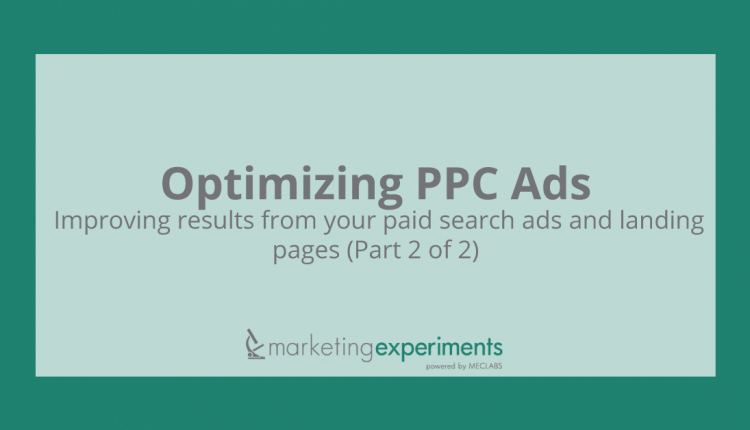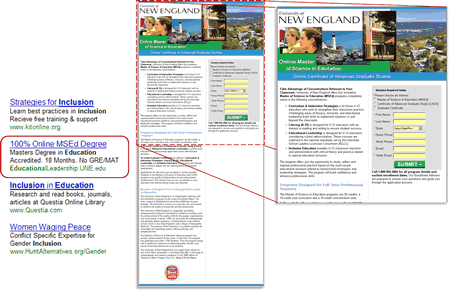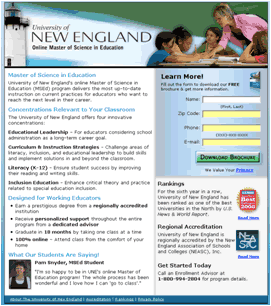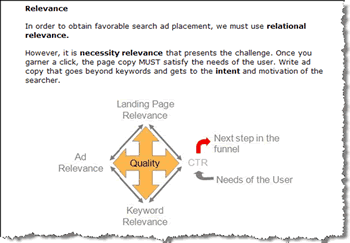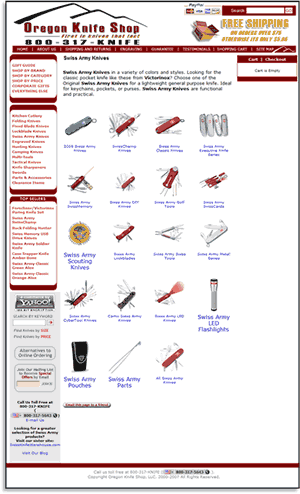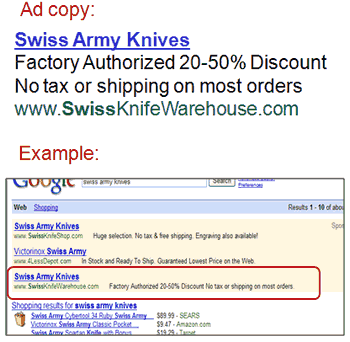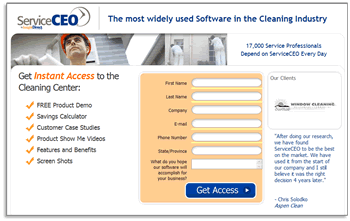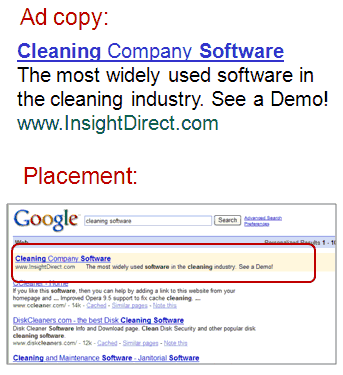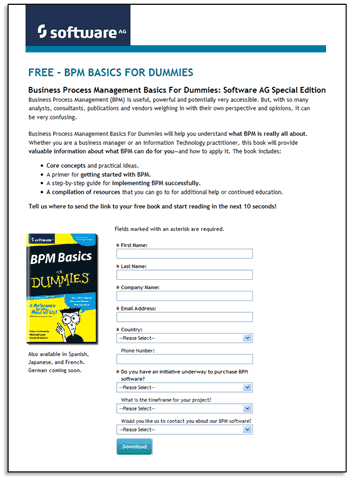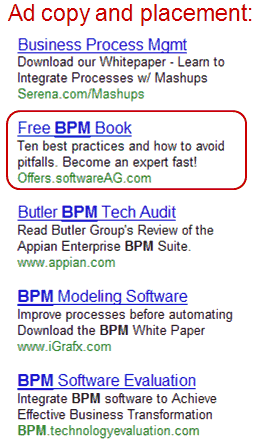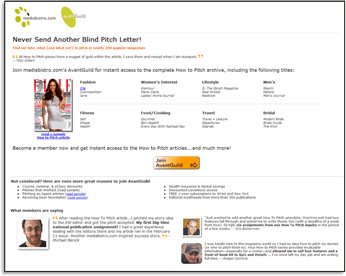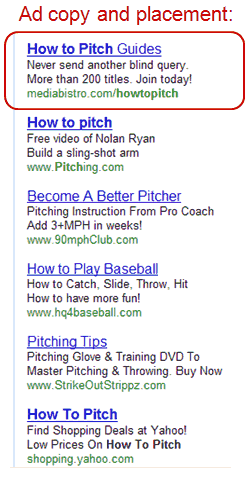Increasing competition and bid prices are making conversions harder to achieve with paid search campaigns. To maintain a dominant position in PPC, you need to constantly improve your ads and landing pages.
The challenge: How can you determine what changes to test, what to keep, and what really works when optimizing a paid search campaign?
During our July 30, 2008, web clinic, our optimization team reviewed pay-per-click ads and landing pages from a cross-section of markets: eCommerce, lead-gen, B2B, and B2C. All information was from real campaigns submitted by clinic attendees.
The goal of this clinic was to demonstrate how the MarketingExperiments Conversion Sequence can be used to identify obstacles to conversion, and examine best practices, tests and strategies that would help these and other campaigns improve their ROI.
The clinic also included a case study from a former optimization workshop participant who used these same principles and strategies to improve a PPC campaign’s conversions by 300% while reducing cost-per-conversions by 69%.
Editor’s Note: You can find the second part of this two-part clinic here:Optimizing PPC Ads: Improving results from your paid search ads and landing pages (Part 2 of 2)
The audio from the Web clinic on this topic can be downloaded here:
Case Study: University of New England
Matt Celano attended our June Landing Page Optimization Workshop in Ponte Vedra Beach. He learned the MarketingExperiments Conversion Sequence in detail and used it to optimize a client’s PPC campaign that had been on hold since April due to low ROI.
Matt then developed a new landing page for the campaign and tested it with PPC keywords such as: curriculum instruction, educational leadership, literacy K-12, inclusion education, and principal license.
“When we turned it back on we found additional keywords that had been ineffective before due to relevance,” Celano said. “We were hoping for a 10-15% lift in conversions.”
Landing page issues that Matt identified included:
- Friction in the header, form and button call-to-action.
- Incentive and sub-value proposition were missing.
- Motivation: Traffic for a specific concentration was being sent to a generic page.
- Value: There was no clear value proposition expressed.
- Anxiety: The decision point had no privacy policy or supporting elements, such as credibility indicators.
Key optimization changes made included:
- Clarified eye tracking, added sub-value proposition and an incentive.
- Friction was reduced with a cleaner masthead, fewer form fields and auto formatting of the form.
- Anxiety was reduced with a privacy policy and credibility indicators: accreditation, a testimonial with photo, a more prominent US News and World Report logo and link to the ranking.
- Decision point: The call-to-action was changed, the phone number was moved down away from the button.
Results (overall comparison)
| Landing Page | Conversion Rate |
Conversions |
|---|---|---|
| Original |
2.71%
|
18
|
| Optimized |
4.9%
|
72
|
| Variance |
2.19%
|
54
|
| Relative Difference: |
80.81%
|
300%
|
| Landing Page | Cost Per Conversion |
|---|---|
| Original |
$194.40
|
| Optimized |
$60.84
|
| Variance |
-$133.56
|
| Relative Difference: |
-69%
|
What you need to understand: Optimizing the landing page and increasing its relevance to users reduced cost-per-conversion by 69% and increased lead volume by 300%.
Conclusions
- Be prepared to sacrifice some clickthrough rate in exchange for higher conversion rates. The CTR on this campaign dropped from 0.14% to 0.05%, yet the ROI increases far outweighed that dip.
- Consider radical redesign or multivariate tests to identify the prime movers on a landing page, then refine the results with A/B testing.
- Look for ways to increase relevance between landing pages and ads by examining the motivation and mindset of visitors. This can be done with channel mapping (a topic we will cover in more detail for an upcoming clinic).
Next steps
Additional tests that are now underway or planned include:
- Landing pages specifically optimized for degree and certificate concentrations and even greater relevance to PPC ads for example, a photo of a principal instead of a teacher, for traffic derived from “principal license” ads
- A/B split testing to compare results against the sequential test results and isolate additional factors
- Testing stronger testimonials, single-column design, branding changes, and a different incentive
“What really struck me was being able to run ads and keywords we had turned off because cost-per-lead was too high or click-rates were too low,” Celano said. “The results completely changed the dynamics of that channel for us.”
Editor’s Note: The MarketingExperiments Conversion Sequence is taught in full detail in our Landing Page Optimization workshops and certification courses.
Two Types of Relevance
A great deal has been written about relevance in PPC campaigns. However, most of that information boils down to repeating keywords and phrases in ads and landing page copy. That is absolutely an important principle yet it’s only one part of the challenge.
Our research indicates that, to achieve the strongest results, campaigns must account for two types of relevance:
1. Relational relevance This is readily identified by search engines through algorithms; it refers to matching search terms against ad content.
2. Necessity relevance In the mind of the user. This is the reason landing page copy must go beyond reapplying keywords and match the user’s motivation and intent.
PPC campaigns need to achieve relevance between the user’s deepest motivation, his or her intent, and what you are actually presenting. That requires you to think more deeply about your paid search campaigns and about your landing pages. Do not just think of relational relevance alone.
Editor’s Note: For a more detailed review of this concept, please refer to our July 27, 2007 brief: PPC AdvertisingThe Relevance of Relevance
Review of Submitted PPC Campaigns (Ads and Landing Pages)
Campaign 1: Oregon Knife Shop
Analysis (Aaron Rosenthal)
- You are doing a good job of meeting the search term expectations in the title of the ad, but I do not see it in the body. Make sure you are testing these terms in the body.
- There is no tax or shipping on most orders. Almost every time we have tested using no tax versus free shipping, free shipping performs better. When using the word “free” in ads, test it in uppercase letters.
- Your ad mentions factory authorized 20% to 50% discounts. Specify your largest discount by using “Up to 50%” instead.
- Test using the free shipping with specific, quantifying language, such as, “Free shipping on over 2,412 Swiss Army Knives” in the body copy.
- If you offer a money back guarantee, that is absolutely something you also want to test in your pay-per-click ad.
Analysis (Flint McGlaughlin)
- The “20% to 50%” is read this way in most peoples minds: 20% not 50%. They are going to say, okay, two items are 50% off, but everything else is 20% off. What you are really communicating in the phrase is likely most things are around 20% off and every other website out there has got a 20% discount. There is nothing special now about all those characters on the first line of the ad, and it detracts from the impact of the ad.
Analysis (Jimmy Ellis)
- If you look at the ad, the ad is actually much better than the landing page. This is a commodity product and so it is not like you are trying to sell someone a Swiss Army Knife. You are trying to sell someone on buying a Swiss Army Knife from your company.
- Everybody on this page already knows about Swiss Army Knives. That is what they are typing in as search terms. So they are not looking for pocket knives but looking for Swiss Army Knives, same thing for Victornox. You should test using a dedicated page for both of those terms that expresses your value proposition.
- I want to know why I should buy from Oregon Knife Shop. Your ad says your knives are factory authorized, and there are 20% to 50% discounts, so you want to say that again on the landing page. If I scan the page I see free shipping at the top right, but from the logo, your eyes are drawn down to the image of the knives because that is what you are looking for, so most people will miss the discount notice.
- To get someone to continue and order, you have to get them interested in this page and your company and let them know that Oregon Knife Shop has the best deal. What are ways that we can do that? We can reduce anxiety by saying your factory authorized it. You can prove it with the seal, put that on the page. You want to confirm that the discount in the ad is visible on the landing page. You want to remind them of that throughout the entire order process.
- A guarantee is offered but not communicated on the page. Make sure that the value proposition you are communicating in the ad is very clear on the landing page. That’s how you get the initial relevance in terms of your ads and landing pages. Then once the customer gets there, you use your company’s value proposition to show them why and how to buy a specific knife on the page.
Campaign 2: Cleaning Software
Analysis (Aaron Rosenthal)
- When I read this ad and look at the page, I’m a little confused because in your ad you are promoting a demo and on the page you are promoting free access. So I’m not sure what the offer it is.
- Free trial, free demo … using the word “free” in your ad is going to be one of the highest pulling elements in the pay-per-click ad copy. Use it in the ad and page copy as well.
- You have got “cleaning company software” as the title of your ad for cleaning software. I would test a version that said “free cleaning software” and I bet the clickthrough rate would skyrocket. You’ll want to keep track of how it converts on the backend, but I think you’ll get a lot more people to the landing page.
- Make sure that you are reiterating your message not just in your body copy, not just in your title, but also in your domain. That offers you a space to actually advertise and to get your messages across to customers. If your domain is not specifically related to the product or service people are looking for, in this case “Insight Direct” instead of “cleaning software”, test using a subdomain or a file folder extension on that URL and I think you will see a slightly higher click-through rate on this particular ad.
Analysis (Flint McGlaughlin)
- Clarity trumps persuasion. We worry too much about our ability to persuade, instead of focusing on the ability we actually have and maximizing its application in our marketing efforts. What’s wrong with this process is that the Cleaning Company Software drives me to a site where it says Service CEO and I cannot understand what is Service CEO and then I look down and see Insight Direct and I have now Cleaning Company Software, Service CEO and Insight Direct. I’m unclear.
- When people visit a Web page, they have two or three questions in mind. The first one is: Where am I at? The second one is: What can I do here? And the third one is: Why should I do it? Now, when I get to this page and I ask where am I at, I’m not sure, there is nothing about this page that looks like software and the part that says software is up above the banner. In the ad you promised me a demo, and now I’m seeing “access” instead.
- You are selling a solution but this page hasn’t done anything to identify the problem. I cannot tell the problem you are solving for me. There is nothing on this page that helps me know the problem you are solving, so you are losing me right there. Assuming that is dangerous.
- This is an example of Necessity Relevance. It shows how someone very familiar with their own product can design a page yet not quite get inside the mindset of the person coming to the page. Someone might argue that everybody in the industry knows what Service CEO is, but if that’s the case it should have been in the ad and it is not. The ad says Cleaning Company Software. The two are disconnected and are lacking in both types of relevance.
Analysis (Jimmy Ellis)
- If you use any imaging, test a picture or image of the software solution that you are trying to get people access to, rather than stock images of people cleaning. The context and relevance are very different.
- Some of the best copy, like, “17,000 service professionals depend on Service CEO every day” is on the far right. With the eye-path this page uses, most visitors will totally miss that copy. I would use the exact number because it sounds more legitimate and I would test using that in the pay-per-click ad copy.
- There is not enough content to build enough trust or answer enough of my personal questions to give you my personal information to learn about this product. I see a free product demo, but I want to be convinced before I give you my personal information that you have a solution that fits my needs and that is not done well in this particular page.
Campaign 3: Software AG
Analysis (Jimmy Ellis)
- So, when I look at this particular ad I see free BPM books, but unless you already know what BPM is or that acronym, most likely that term will not work as well as filling out the actual acronym. Test if “business process management” will fit in the number of characters you have to work with or use a version of it in the headline or at least in the ad copy text.
- The URL is offers.softwareag.com. Use your URL to your advantage to add some relevance to the actual domain name.
- In terms of the actual copy of 10 best practices you had a little bit of defaults, but unless you already understood BPM, it means nothing to you, it is for a while, what is BPM but your idea of business management professional and so now understand what the ad is and so in terms of relevance I would try to test using the acronym versus the full word, the other thing is I do not see too many value props up there. I think it is free. So yes, you have free in the headline but test free in the subtext too, you mean you could say free download, you could specially use some other variations of the headline text if you use the acronym on this one.
- With the page copy, test specific language. How is this going to benefit me or my company personally? Is it going to help me save 40% of my overhead costs? Make the copy more specific so customers can identify with one or more of the problems and/or solutions on the page. I would try something like, “learn to implement BPM in 14 days or less.” Something that makes it quantitative, personal and relevant to their particular needs.
Analysis (Flint McGlaughlin)
- Nobody coming to paid search is looking for 10 best practices. That might have worked when white papers were new, but how many of us are going to rush to a website to get 10 best practices.
- Web optimization is all about cognitive science and cognitive psychology. The person who sees this sees 10 best practices. Now the person who writes this ad is thinking: “Okay, let me think of something I can give that will get people to the site. Once I get them to the site, I can give them something more to get them to complete the form, but I need to think of something that really appeals to them and I have got to stand out against all these competitors, so I’ll offer 10 best practices and I will push it so that they can become an expert fast.”
- The person who reads this thinks: 10 best practices in how I avoid pitfalls and the first thing they think is yeah, right, 10 best practices. First of all everybody on the Internet is claiming to give away some kind of free piece of information and it is typically worse than what they pay for it.
- It’s not 10 best practices associated with some great guru or Google expert, if you had a name that they all recognized and you said top 10 principles from so and so or an interview with so and so, or you could increase the authority of what the 10 best practices are and it might mean something. But it does not. As it is now it’s a waste of digital link, it does not appeal to the people that are coming here.
- You need to tap in to what is on their mind; they did not come to the paid search engine looking for 10 best practices. They came to the paid search engine to solve a specific problem and they have something in mind as to what can be the solution and you either want to give them the solution they are expecting or you have to educate them that there is a better kind of solution than the one they were expecting. You cannot do the second in a paid search campaign ad. You have to do that in a much more elaborate marketing campaign.
Analysis (Aaron Rosenthal)
- This is a great example of how to use, or how not use, subdomains and file folders in your URL. Do not add something like “offers” because that adds anxiety to somebody. If it is a free book, use the “free book” in the URL: www.freebook.softwareag.com or the name of the actual product that they are going to get as a download.
- The ad is identical to the one running for the underperforming keywords, but some of those terms are not in the ad copy. Test splitting up ads into groups or using variations with greater relevance to those specific keywords, because they are directly tied to the motivation of the people searching.
Campaign 4: MediaBistro
Analysis (Aaron Rosenthal)
- Regarding the keywords related to “pitch”, this campaign needs to do a better job of specifying what the users are looking for, because all of the other ads shown for this term refer to baseball. Use “baseball” as a negative keyword, and others, so if people are looking for baseball players or pitching tips or videos or increased miles per hour, your ad isn’t shown. This will improve the relevance of your ad impressions.
- The ad uses language like “join today” but at this point, when somebody has just seen your pay-per-click ad, they are not necessarily ready to make that decision yet. You are asking them to join today before they have actually seen the offer, or the product, or the benefits. Be careful in using language like that, because it can dramatically affect your click-through rate on a pay-per-click ad.
Analysis (Flint McGlaughlin)
- The mind is moving in the sequence of thoughts at a very specific pace and what happens when they come to an ad like this is, the pace of thoughts is altered, it slows down, and sometimes it stops. You never want it to stop or slow down in this early stage of the pipeline. Searchers need to see instantly what this is and instantly how it benefits them. If I have to slow down to figure out what the page is talking about, you are losing me and even if you get me, you probably will not get the next person because of the fact that you’re creating a kind of internal friction in the thought process.
- Look at your pay-per-click ad and ask yourself is there anything about my ad or my headline that is actually slowing them down before they get to the landing page? And then in the landing page we are slowing them down again? Visitors will evaluate your ad in less than three seconds.
- On the page, test an e-mail capture with that button to enable basket recovery. Collect that piece of personal information on this page so if visitors abandon it on the next step, there’s commitment involved, and you can still market to them later and reiterate the benefits of being a member.
Analysis (Jimmy Ellis)
- I’m not familiar with this particular product, but looking at the page, if you get down to the “not convinced yet?” items, those are most of your primary value proposition.
- You absolutely want this kind of page to start with a good relevant headline, then move intro your intro bullets and text. Initiate the conversation with customers, help them identify the source of pain that joining this service is going to solve, and offer a personal benefit to them that addresses their particular problems.
- The page layout is really wide, with elements scattered all over the place, above and below the call to action, and the eyepath and flow are not optimized. There are so many sections that it’s just not clear. Make these simple so the page flows naturally down, from the headline to intro bullets and text to maybe the example and then the call-to-action.
Editor’s Note: A fifth site, submitted by FreedomVOICE Systems, was optimized following the clinic.That critique was posted on the MarketingExperiments blog.
- To optimize PPC campaigns, you need to address relevance as it applies to users’ motivations and mindsets – this goes beyond simply using the same keywords in ad and page copy, and includes two types of relevance:
- Relational relevance readily identified by search engines through algorithms; it refers to matching search terms against ad content.
- Necessity relevance In the mind of the user. Landing pages must go beyond reusing keywords and match the user’s motivation and intent.
- Don’t assume that even great results are your ultimate results. Make testing, analysis, and optimization a consistent, cyclical process.
- The principles of the MarketingExperiments Conversion Sequence can help you significantly improve the testing and optimization of PPC campaigns. We offer more in-depth information on the sequence throughout this site, as well as in our Landing Page Optimization workshops and certification courses.
- Editor’s Note: You can find the second part of this two-part clinic here: Optimizing PPC Ads: Improving results from your paid search ads and landing pages (Part 2 of 2)
Related Marketing Experiments Reports
- PPC Advertising
- Optimizing Your Landing Pages Part One
- Optimizing Your Landing Pages Part Two
- Online Ad TestedHow Matching Ad Design to Context Improved Conversion by 127%
- Optimizing Landing Pages
- PPC Ad Copy Tested
- Google Adwords Select TestedNew Insights from Our Sustained Testing of the Google AdWords
- Google AdSense TestedLearn How to Maximize Your Paid Search (PPC)
As part of our research, we have prepared a review of the best Internet resources on this topic.
Rating System
These sites were rated for usefulness and clarity, but alas, the rating is purely subjective.
* = Decent | ** = Good | *** = Excellent | **** = Indispensable
- Paid Search (PPC) ****
- PPC (Pay-per-click) Advertising ****
- Search Marketing ****
- Consistency Is Key in the PPC Conversion Process ***
- Ten Ways to Waste Your PPC Budget ***
- Profitable PPC ***
- The New Google Keyword Tool: How To Apply Keyword Research to Your Site ***
- PPC Copywriting: The Evolution of a PPC Split Test ***
- Using Paid Search? Here’s How You Can Maximize The Impact of Your Ads **
Credits:
Managing Editor — Hunter Boyle
Copy Editor — Frank Green
Contributor(s) — Flint McGlaughlin
Aaron Rosenthal
Jimmy Ellis
Bob Kemper
Production — Mel Harris
Austin McCraw
Cliff Rainer
Holly Hicks



